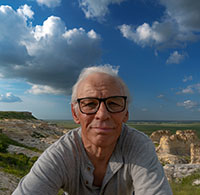A greater prairie chicken on lek in north central Kansas.
(photo by: ©Dan Peak)
Each spring, before the sun crests the horizon, a peculiar ritual unfolds on the rolling grasslands of north-central Kansas. The stage is a windswept hilltop known as a lek — a place where male greater prairie chickens gather to compete for mates with booming calls, foot-stomping dances, and the inflation of vivid orange air sacs on their necks.
This April, six photographers traveled from as far away as Canada and as close as Kansas to take part in a workshop led by conservation photographer Noppadol Paothong. The group was based at Ringneck Ranch, a long-standing pheasant hunting lodge near Tipton, Kansas. The lodge, founded in 1983, served as home base for early morning excursions to the lek site located about five miles away.
Early Mornings on the Prairie
Each day began well before dawn. Participants entered blinds by 5:30 a.m., well ahead of the birds' arrival. The lek was situated atop a hill in a broad sweep of prairie pasture bordered by wheat fields. As the sky lightened, the first sounds emerged — the low-pitched booming of male prairie chickens echoing across the grass.
Once the birds arrived, the action escalated quickly. Males squared off in dance battles, inflating their air sacs and stomping rapidly. While often described as comical, these displays carry high stakes. The hens, typically watching from the sidelines, select mates based on display vigor and endurance.
Paothong, who has documented prairie chickens and other grouse thoughout the midwest for many years, emphasized the importance of minimal disturbance. His instruction blended field ethics with practical tips for shooting fast-moving wildlife in low light.
Meals and Memories at the Ranch
After returning from the lek, we gathered at the Ranch House for breakfast — a self-serve spread of fruit, yogurt, toast, and a rotating main dish. The breakfast pizza stood out for me. Lunch was simple and warm, like a bowl of chili waiting after a cold morning outdoors.
The evening meal was the real anchor. Supper was served at the long dining table — lasagna one night, pork chops/baked potato another, followed by homemade pies: cherry one night, peach next. The dining room was where we downloaded the day, swapped stories, and shared quiet moments of banter before calling it a night. For me, the meals felt straight out of my youth — not just the food, but the feel of it: familiar, grounding, and made to be shared.
A Disappearing Display
The greater prairie chicken once ranged across vast portions of the American Midwest. Today, habitat loss and fragmentation have dramatically reduced its numbers. According to the National Wildlife Federation, the species now occupies less than 15% of its historical range.
A Short Stay, Long Memories
The workshop not only offered a photographic opportunity but a rare glimpse into an increasingly fragile ecosystem. It was a mix of quiet observation, technical challenge, and appreciation for a vanishing piece of the prairie. The early mornings, the stillness of the blinds, and the booming calls rising from the grass created an experience I won’t soon forget. It was a good week. The kind that stays with you.
Further Reading






